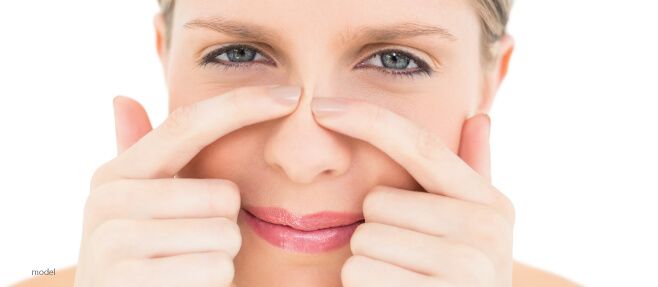Nose Reshaping Without Surgery: Which Issues Can Be Corrected?

Nose reshaping without surgery, also known as non-surgical nose reshaping or liquid rhinoplasty, is an increasingly popular cosmetic procedure. This approach offers a range of benefits for those seeking to address nasal imperfections without the need for invasive surgery. In this blog post, we will explore what non-surgical nose reshaping entails, how it is performed, and why it might be the ideal choice for you.
What is Non-Surgical Nose Reshaping (Liquid Rhinoplasty)?
Non-surgical nose reshaping is a minimally invasive procedure that uses injectable fillers to alter the shape of the nose. Unlike traditional rhinoplasty, which involves surgical alteration of the nasal structure, liquid rhinoplasty achieves its aesthetic goals without incisions or significant downtime.
How is it Performed and What Fillers are Used?
The procedure typically involves the use of dermal fillers, such as hyaluronic acid-based products like Juvederm Voluma (my personal favorite). These fillers are injected into specific areas of the nose to add volume, smooth out imperfections, and create a more symmetrical appearance. The process usually takes 15 to 30 minutes. Because this is an advanced treatment, it must be performed in a clinical setting by a skilled practitioner who has ample experience.
Liquid Rhinoplasty Results
While the results of liquid rhinoplasty can be quite profound, they are not permanent. Most patients can expect the effects to last between 12 and 24 months, after which the body gradually absorbs the filler material.
Correcting Cosmetic Issues Without Surgery
A skilled injector can use non-surgical nose reshaping to address several common nasal issues, including:
Depressions or indentations on the nose:
- Fillers can be used in a targeted way to add volume to areas around an undesired indentation or depression.
- This technique gives a more symmetrical or straight appearance.
- Although it might sound like adding volume will just make the nose bigger, making the nose straighter makes it appear smaller and more proportionate with the face.
Tip reshape:
- For noses that tip down or appear too short, fillers can be used to create a better shape.
- A bulbous nose can be de-emphasized.
- The tip can be made to point up and be more in sync with the rest of the facial features.
Crooked nose:
- Fillers can be used to fill in areas where shadows emphasize crookedness.
- This results in a straighter-appearing nose.
Scarring:
- In instances where scarring or other damage is present along the nose (mostly after injury), fillers can be used to smooth out the area around the scar, making it less visible.
Risks of Liquid Rhinoplasty
- Vascular occlusion: Any filler if placed into or around a blood vessel can obstruct blood flow to the skin. There are certain nose areas prone to this complication, such as the lateral tip and nostril edges. These areas must be strictly avoided. If vascular occlusion occurs, the treatment is stopped and hyaluronidase is immediately injected to dissolve the filler that is causing the problem.
- Blindness: Although very rare, cases of blindness following fillers injected in the face have been reported.
- Bruising: Like with any filler injection, bruising can occur when the nose is injected. Taking Arnica after treatment and applying ice will minimize this complication.
Why Choose Non-Surgical Nose Reshaping Over Rhinoplasty?
Non-surgical nose reshaping offers several advantages over traditional rhinoplasty, making it an attractive option for many patients.
No surgery means no recovery time:
- Unlike surgical procedures, liquid rhinoplasty only requires a few days recovery time. Most patients can resume normal activities the day after the procedure. Any swelling diminishes a few days after the treatment.
Minimal pain and no need for anesthesia:
- The procedure involves minimal discomfort and typically only requires a topical anesthetic to numb the area.
Great for minor to moderate Issues:
- It is an excellent way to treat minor to moderate nasal imperfections without the need for invasive surgery.
Temporary results allow for flexibility:
- The temporary nature of the results means that if a patient decides they prefer their original nose, the changes are not permanent. Since hyaluronic acid fillers are dissolvable, any undesired result may be reversed.
Less expensive in the short run:
- Non-surgical nose reshaping is less expensive than surgical rhinoplasty. However, the need for regular treatments to maintain the results can add up over time.
When is Rhinoplasty the Best Choice?
While non-surgical nose reshaping is an excellent option for many, there are situations where traditional rhinoplasty is the better choice.
Severe issues or dramatic results needed:
- Surgical rhinoplasty is necessary for addressing more severe nasal issues, such as significant humps and bumps on the nasal bridge, major reshaping of the nostrils or severe deviations.
Permanent results desired:
- For those who want a permanent solution without the need for future treatments, surgical rhinoplasty is the better option.
Functional issues:
- Only a functional rhinoplasty procedure can address breathing issues. Non-surgical reshaping will have no effect on the nasal passages or airflow. Rarely, filler can increase nasal obstruction if placed incorrectly in the nose.
Non-surgical nose reshaping is a revolutionary option for those looking to correct nasal imperfections without the need for invasive surgery. With minimal pain and downtime, and the ability to address a variety of issues, liquid rhinoplasty offers a flexible and effective solution. However, for those with more severe nasal problems or who desire permanent results, traditional rhinoplasty remains the gold standard. Consulting with a qualified provider will help determine the best approach for achieving your desired aesthetic goals.
